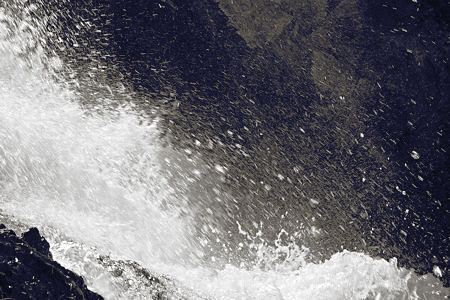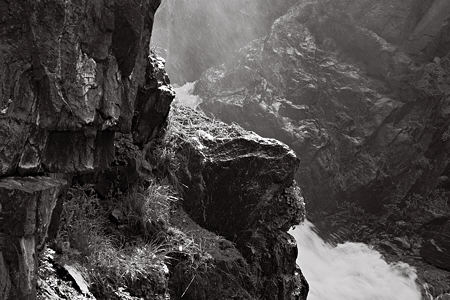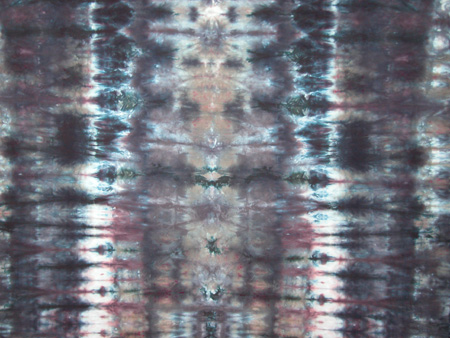Posted by Steve Durbin on July 10th, 2007

I could be accused of being stuck on my waterfall project lately, but my excuse is that it seems to connect to various other recent posts and comments. Anyway, it’s the work that I’m closest to at the moment, so it makes sense to write about it while it’s fresh. Fresh enough that the ideas are still churning around without order, which in truth is how I like it. I’m inclined by nature to let things ferment in their untidiness, not attempting to resolve or define, hoping/knowing that that will happen on its own eventually.
So this post is partly a record of the connection between concepts and execution, between thinking about the photographs and making them. In the present case, this is a pretty loose and interactive connection, perhaps similar to David’s “chickens, then eggs, then more chickens…” or Leslie’s “dialogue with the idea going back and forth with the making in a pretty comfortable way.” Karl also has been considering the role of concept in art, and I think his question, “Is art something we make, or discover?” is about the same thing. In other words, do we create from a concept or learn by doing? The answer, of course, is that both go on at once, but how it plays out is always different, even for me alone on this single project.
more… »
Filed in abstraction,landscape,photography
- Comments closed
Posted by Birgit Zipser on July 9th, 2007
Filed in art and politics
- Comments closed
Posted by Karl Zipser on July 7th, 2007

Painting
From Life vs.
From Photos
Conceptual art represents concepts.
That seems obvious.
The simple statement has some interesting implications, however. Let’s explore by looking first at another art-form: still life.
What does still life art represent? The still life, obviously. Each still life painting shows a given set of objects. Is the still life art the same as the still life itself? Of course not. It’s a representation: the appearance of a still life on a canvas is an illusion.
Does the artist create the objects in the still life? Perhaps he or she might throw the vases and cut the flowers, but this is not essential.
Must the objects be valuable or beautiful? Of course not. The value of the still life art depends on the quality of the representation, not on the quality of the things represented.
Now, back to conceptual art. more… »
Filed in Uncategorized
- Comments closed
Posted by June Underwood on July 6th, 2007
In an interview for a quilting magazine recently, I was asked why I liked oil paints. I found myself speaking lovingly about the names of paints — burnt sienna, cadmium yellow, quinacridone magenta, perylene black, French ultramarine.
My response surprised (even) me. I hadn’t actually thought of the names of colors as a reason to like a specific medium. Thinking it over, however, I came to understand why I fell into praising the precisely designated oil paints. And watercolor paints. And even acrylics.
It isn’t the names, charming as I find them, so much as it is that the names signify a specific color that holds fairly true across media and brands.
To understand the hold that standardized pigments have for me, you have to know that I began my color education with textile dyes rather than pigment paints. Once you have struggled with making art with dyes, you find that using pigmented paints seems ridiculously easy.
Here are reasons why dyes are inherently difficult to control.
more… »
Filed in materials,technique,Uncategorized
- Comments closed
Posted by Sunil Gangadharan on July 5th, 2007
Under the catchwords of accessibility and inclusiveness, a lot of artifacts in the art world are losing its original meaning and interpretations thereof. Simply put: We inhabit a culture of simplification and generalization with the hopes that unpretentious agendas would be understood and assimilated by a larger audience. This has been documented extensively in other fields and is now seen to be creeping into the arts as well. Two examples from either sides of the Atlantic would further illustrate my point. more… »
Filed in art world,Uncategorized
- Comments closed
Posted by Steve Durbin on July 3rd, 2007

As regular readers may know, I’ve been intrigued by resemblances noted between some of my photographs, particularly the recent waterfall series, and those of Clyfford Still, the eccentric Abstract Expressionist determined to go his own way, living most of his life in relative isolation from the art world. Over the last year or so, I have sensed some movement toward abstraction in my work and I would like to explore that. What is abstraction for me? How does it relate to representation? What and how does it mean? I’m not aiming for a more sophisticated Statement, I’m just trying to better understand what I do and what others have done and what I can learn from it.
more… »
Filed in abstraction,landscape,photography,realism
- Comments closed
Posted by Karl Zipser on July 2nd, 2007

Painting
From Life vs.
From Photos
In my previous post I discussed conceptual- versus procedural-based art and asked how an artist could have the two dimensions interact. This got me thinking about how different art forms mix these aspects. Contemporary conceptual art, for example, tends to be big on ideas and light on craft, whereas something like the Painting a Day movement is more procedure-based. Renaissance art, in contrast, combined conceptual and procedural components.
Below I try to express this distinction in a two-dimensional plot where the axes are Conceptual and Procedural.

Note, nothing about this hypothetical representation says anything about the quality of the artwork. It is possible to have a technically developed artwork, full of ideas, that is just plain bad. Conversely, a simple, non-conceptual painting could be something wonderful.
Where on this graph would you like your work to be? Where do you think you are now?
Where is the money today? It seems that the conceptual gets rewarded more than the procedural.
Filed in being an artist,Uncategorized
- Comments closed





